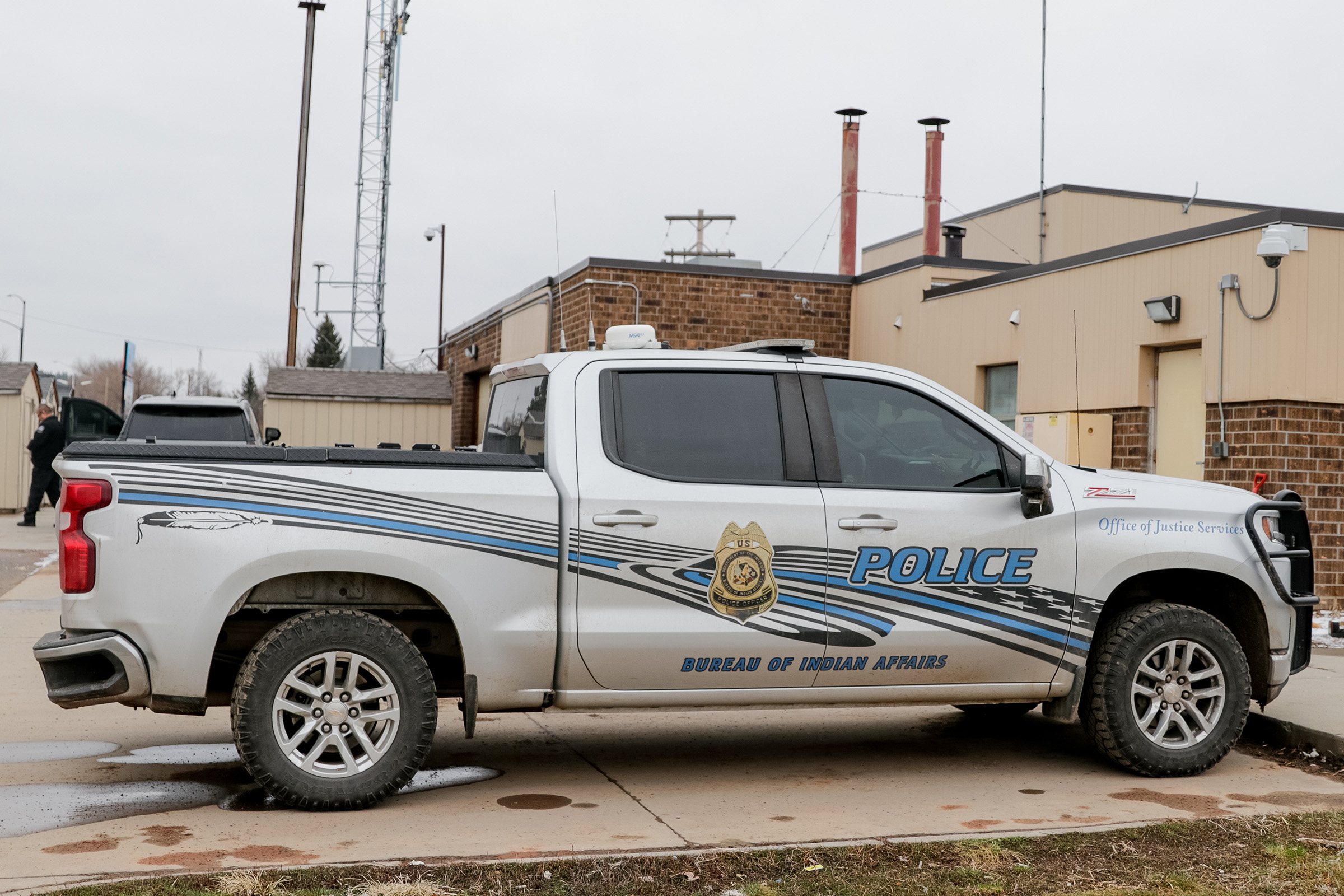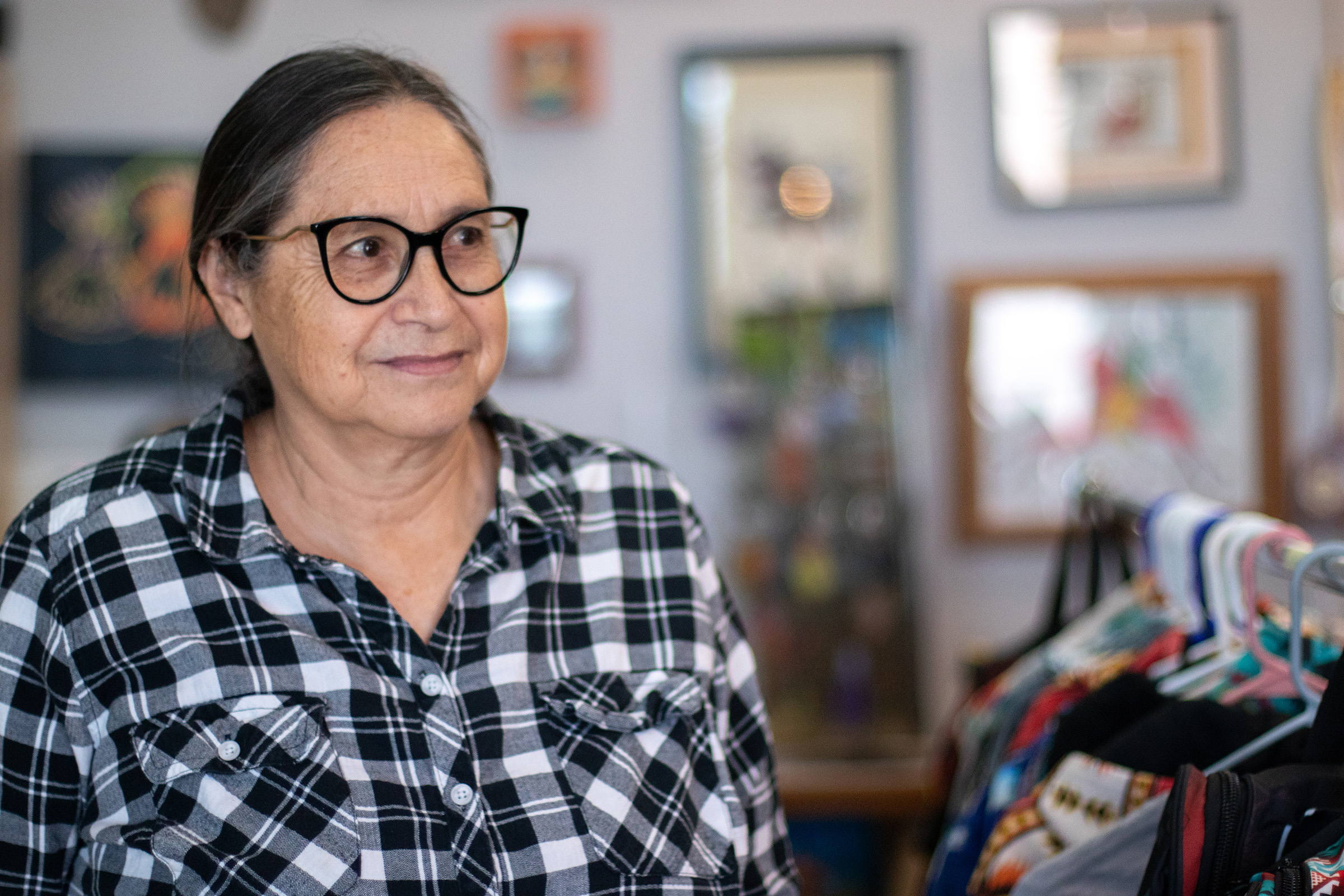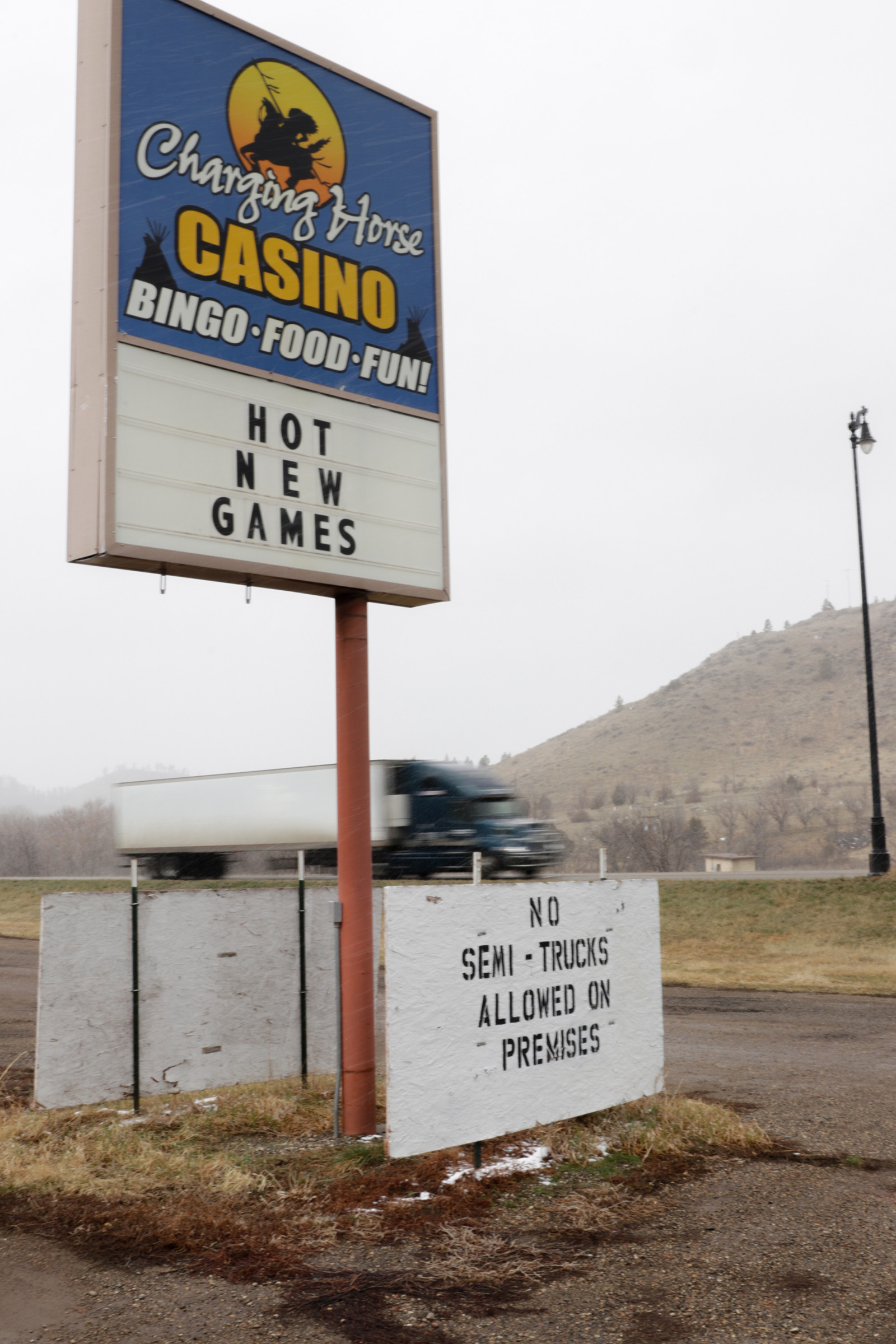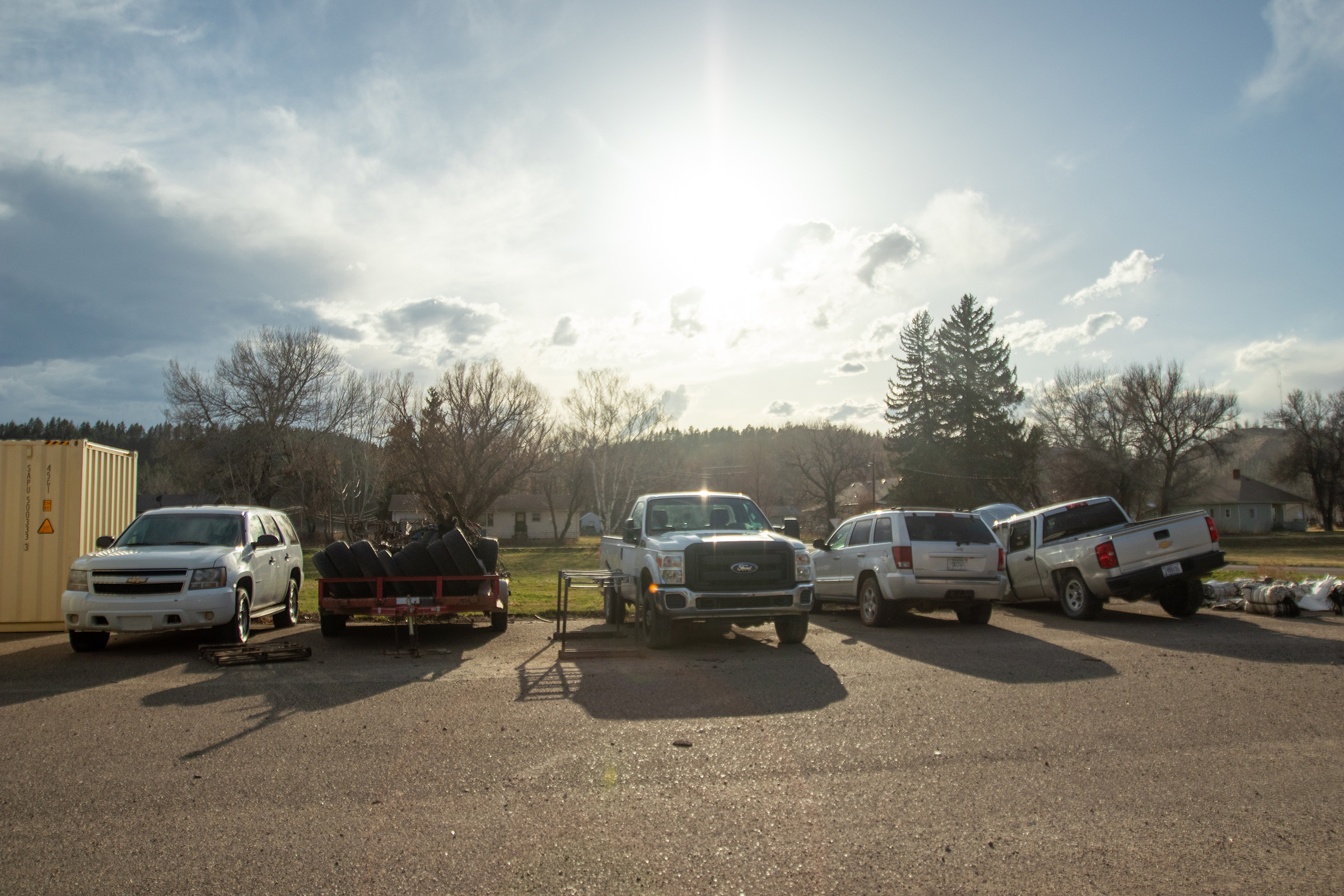Breach of Trust
Tsis tsis’tas take law enforcement reform into their own hands
Story by Jane Rooney. Photos by Nance Beston.
John Grinsell should be retired, he should be relaxing back in his community. Most of all, he should be looking back on his long career as a police officer with a sense of pride.
Instead, Grinsell came home to botched crime scenes, sloppy investigative work and dead cases that the police on the Northern Cheyenne Indian Reservation didn’t seem to care about.
He remembered two cases in particular: In the first, the police found a body of a non-tribal citizen, decapitated under his vehicle on the side of the road. It was likely an accident. However, there was no investigation to prove that. Instead, the police, from the Bureau of Indian Affairs, seemed more concerned with cleaning up the scene and moving on.
“They come out, they take pictures and they take statements and that’s it,” Grinsell said. “There’s no measurements, there’s no finding of facts – and then they clean the blood off.”
The second case was when the confessed killer of Christy Woodenthigh, who was murdered in spring 2020, was acquitted. Three BIA officers testified they did not write or file police reports of the crime, did not gather evidence and moved the suspect’s vehicle from the scene themselves when they should have had it towed to preserve evidence.
Enlarge

“I think her case was one of the cases that kind of made the tribe act on contracting and starting to take a serious look at law enforcement here on the reservation,” Grinsell said.
The Tsis tsis’tas people are faced with a crime epidemic. The Northern Cheyenne Indian Reservation has become notorious for its crime rates. Instead of its rich culture and history intertwined with Montana, the tribe is known more for its high rates of missing and murdered women, lack of jail facilities and a sleepy court system.
Tribal administrators say this perception has been forced on the Tsis tsis’tas by inadequate federal funding and a lackadaisical police force, specifically the BIA police.
The BIA police, a service provided by the federal government, is understaffed and under-trained to handle a large land area like the Northern Cheyenne Indian Reservation. It is largely restricted prosecuting to major crimes. Meanwhile, smaller crimes have escalated to the point where the community has been forced to stand up and find solutions, including solutions to problems they don’t have the authority to resolve.
“It’s a well-known fact that when you take care of the little stuff, you take care of the big stuff,” Grinsell said. While the FBI has been helpful in aiding major investigations, according to Grinsell, the BIA holds the authority and responsibility to resolve cases outside of the FBI’s jurisdiction.
This is why Grinsell came out of retirement to create the Northern Cheyenne Investigative Service in January 2021. The service is a tribal law enforcement department, funded by the federal government under a 638 contract. However, the BIA resisted splitting jurisdiction with the new investigative services. Northern Cheyenne Investigative Services ultimately had to sue the BIA to distribute funding.
On Valentine’s Day 2024, when Grinsell requested to expand Northern Cheyenne Investigative Services’ resources to fill vacant BIA police officer positions, the BIA announced it was cutting those available positions.
“When we asked why, they said they were unfunded positions they couldn’t recruit and fill them, so they moved them somewhere else,” Grinsell said.
In 2022, a BIA staffing report indicated that 20 officers were supposed to be on duty on the Northern Cheyenne Indian Reservation, but now cut those positions to 12. In an email message, Robyn Broyles from the BIA Office of Public Affairs said the agency filled 10 positions, while Grinsell and tribal council members say the BIA employed eight positions.
—
Enlarge

The juvenile facility in Busby was condemned, and Northern Cheyenne corrections then converted the Lame Deer Jail into a juvenile facility. Without an adult jail, BIA officers must drive arrested adults 56 miles to the nearest holding facility in Hardin. According to tribal President Serena Wetherelt, many people sentenced for long-term offenses are transported to a penitentiary facility in Oklahoma.
Nationally, other reservations such as the Wind River Indian Reservation in Wyoming and the Pine Ridge Indian Reservation in South Dakota have reported similar issues with law enforcement, according to news reports from the Wyoming Truth and Associated Press. Nationally, tribal reservations have an average of 1.3 officers per 1,000 citizens compared to a rate of 2.9 officers per 1,000 in off-reservation communities with populations under 10,000, according to a 2016 report from the National Congress of American Indians.
On Northern Cheyenne, a reservation with more than 440,000 acres of land and a population of about 6,000, the BIA employs six full-time officers full-time on the reservation, a rate of .998 officers per 1,000 people. In comparison, Broadwater County, which is similar in population to Northern Cheyenne, has about 1.89 full-time officers for the same amount of people, according to the Montana Board of Crime Control’s Law Enforcement Survey of 2020.
—
With limited tribal prosecutorial capabilities, the Northern Cheyenne residents have pursued many avenues to address crime through their leadership. Because most of these initiatives, besides the Northern Cheyenne Investigative Services, aren’t under deputized authority, their efforts are restricted to legislative actions, investigative/reporting operations, business policies and preventative programs to reduce crime.
With the limited number of BIA officers on shift, they’re over burdened. Grinsell cited that the tribe currently has over 1,000 active bench warrants out. However, Juvenile Prosecuting Attorney Virgil Weaselbear said the BIA still manages to keep up on its juvenile delinquency responsibilities.
The difference between the effectiveness of enforcement for minors versus adults is clear — the BIA has a place to hold juvenile offenders.
Enlarge

Juvenile cases work on a faster timeline. Weaselbear said the BIA officers almost always have the paperwork necessary for juvenile cases, likely because these cases move more quickly and tend to be easier for the officers.
“With juvenile trials most kids kind of admit during arraignment,” Weaselbear said. “Hardly ever do these kids deny it. So there’s a lower number that actually go to trial.”
Grinsell hopes one day to expand the Northern Cheyenne Investigative Services division to include five positions that focus directly on violent crime.
“If I had five cops, five criminal investigators. The damage I could do,” Grinsell said.
The Northern Cheyenne Tribe filed a lawsuit on May 7 seeking self-determination funding, which would expand the Northern Cheyenne Investigative Services operation. According to the complaint, the tribe is asking the court to reverse a decision by the BIA that refused to increase funding of the initial contract in August 2023. This would expand annual funding to at least $325,829. Essentially, the complaint states the BIA intentionally misrepresented funding figures to divert resources from tribal law enforcement without effectively utilizing those resources.
—
Enlarge

The Northern Cheyenne Criminal Investigative Services is a three-person operation including Grinsell, his partner Scott Small and a law enforcement officer, Kirby Small. While they receive support on certain crimes with the FBI, the organization requires more resources to handle the volume of criminal activity it is expected to solve. The Northern Cheyenne Investigative Services went from taking around 35-40% of the BIA’s workload to only accepting severe, violent crimes, around 10-20%.
BIA police officers are stationed on different reservations for about a month at a time, meaning officers might not be familiar with the communities. As a result, Tribal President Serena Wetherelt said that BIA response times for calls are incredibly delayed because officers often do not know where to respond.
Much of the tribe’s population resides outside the towns, causing many of these officers to get lost when trying to find houses on a network of dirt roads with limited signage. People on the reservation increasingly began to report crime to Northern Cheyenne Investigative Services upon its creation.
The Bureau of Indian Affairs did not respond to several requests for comment on the particular topic of this story.
Not only are officers not showing up to calls because they cannot navigate, but they’re improperly prosecuting or sometimes not responding to crimes below major felonies due to their minimal resources and lack of jailing facilities, according to Councilman Torrey Davie.
Davie said it’s become common knowledge on the reservation that any crime below a major felony, or a Class A crime, will probably not be properly pursued by the BIA. Tribal lawmakers have recognized that, in order to push the BIA to better police the reservation, they have to rewrite tribal code.
Enlarge

Davie recalled an incident in which BIA police refused to respond to calls of a non-tribal citizen firing a weapon above a parked van with children in it. The police told the concerned citizens to file a police report, as they couldn’t send an officer to the scene because shooting a firearm in public was only a Class B offense.
Appalled, Davie called an emergency meeting, where the tribal council decided to reclassify and rewrite the code for firing a weapon in public to make it a Class A offense.
The revision made some much-needed language changes to include all classifications of firearms, including rifles. The language of the law now reads: “A person is guilty of discharging a firearm in public if he or she knowingly or willfully shoots or fires off a rifle, pistol, or any firearm within the city limits within the limits of any town, community village or any public or private enclosure.”
During the COVID-19 pandemic, when crime started picking up in Northern Cheyenne, citizens noticed that federal law enforcement wasn’t properly mitigating or reporting many crimes. In response, a group affiliated with the traditional warrior societies took action to enforce COVID restrictions and respond to criminal activity.
Davie explained that the tribal council supported the first citizen’s initiative on the condition that the societies refrain from physically intervening with any recorded criminal activity because the group wasn’t under deputized authority.
“When you take a job on, like doing security or something like that, if you call somebody and they don’t respond, you automatically put the onus on yourself to try to at least attempt to fix the situation in some way or form,” Davie said.
—
Enlarge

Community members, specifically business owners, voiced their dissatisfaction with the BIA’s law enforcement. Denise Alexander, the owner of Warrior Trail Jewelry & Gifts in the Lame Deer mall, said that she no longer beads after closing because the mall had experienced so many break-ins.
She said the lack of jailing facilities enables criminals to peruse the streets without fear of criminal prosecution. “So they’re roaming around and they’re breaking in, and they don’t do anything to the people doing the burglaries,” Alexander said. “And I’m sitting here like a sitting duck.”
The mall’s burglaries were all targeted at one store: Dr. “B” ILLZ Cellphone Repair & Electronics. The shop owner, Brandyn Limberhand, claims that around $8,000 of his merchandise had been stolen with no criminal prosecution. The community, through Facebook posts of security footage and word of mouth had discovered the identities of each burglar, but the BIA never pursued criminal charges against these suspects. The BIA had even arrested a woman for one of the burglaries, but according to Limberhand, the trial was dismissed because the charging officer failed to appear in court.
The community is calling for a change and their representatives in tribal government have listened to that concern. The tribe has filed a lawsuit in 2022 to the Billings district court to seek legal remedy, to contract more law enforcement on the reservation. Tribal President Serena Wetherelt, emphasized that the tribe isn’t suing for money, just for an institution of law and order.
Enlarge

The Northern Cheyenne Tribe’s lawsuit to the Department of Interior and Bureau of Indian Affairs, claims the government had failed to fulfill its fiduciary duty to provide federal law enforcement resources. The BIA’s inaction has fueled community distrust in their law enforcement: a breach of trust.
While the BIA has the most resources to prosecute crimes, the complaint of the lawsuit detailed how federal officers were failing to appear for trials and were not filing the proper documentation for cases to be tried in court. Many BIA officers on the reservation have never testified in federal court, according to Grinsell.
“That’s what continues to push us towards the lawsuit: Nobody’s listening, and nothing’s changing things significantly enough to have a functioning society,” Council Secretary Nizhoni Friesz said.
Multiple pieces of legislation distinctly define the Federal government’s duty to properly distribute law enforcement resources to Northern Cheyenne, whether it’s the Treaty of Fort Laramie, the Indian Law Enforcement Reform Act, or the Tribal Law and Order Act.
“The result of these federal laws and Court decisions is that along with the authority that the United States imposed over Indian tribes, it incurred significant legal and moral obligations to provide for public safety on Indian lands,” per the complaint.
By looking at the faces of missing loved ones lining the fence in the center of Lame Deer, the posters calling for justice, it’s evident that the BIA is failing to maintain public safety.
Grinsell drove towards a dilapidated BIA impoundment facility where suspects’ and victims’ vehicles alike are stored and pointed out the utter lack of security for these lots. Many exposed points made the lots vulnerable to tampering, where even a well-defined trail stems out from the unfenced portion of the lot.
“Look at this lot,” Grinsell said. “And they wonder why we have a (Missing and Murdered Indigenous Person) crisis here.”
—
Enlarge

During the same meeting where the council reclassified firearm crimes, it passed an ordinance which designated a task force for the prevention of human trafficking. Councilwoman Silver Little Eagle created the taskforce, the second of its kind in the state. In the summer of 2022, Little Eagle was informed that a number of young, even underaged, girls were being traded for drugs. From there, she decided to initiate the taskforce. This taskforce is mostly made up of stakeholders in victim-centered practices, such as Healing Hearts, which deals with domestic violence, the Department of Human Services, the Northern Cheyenne Investigative Services, housing services and the tribal court system.
“For us at first it was just trying to understand what human trafficking was,” Little Eagle said.
Currently, the tribal council is reworking the legal codes around human trafficking to make justice more victim centered. The council researched other reservation’s human trafficking codes and adopted similar codes to Fort Berthold’s three affiliated tribes. These now codes include both sex-trafficking and labor trafficking.
“Survivors need a solid pathway to address this,” Little Eagle said.
The taskforce created a conference to spread community awareness about human trafficking titled “Walk Home Safely,” which was held in October last year.
Council members worried that the BIA’s inefficiency contributes to delays in missing persons investigations because reports are not being taken seriously. Little Eagle described how the police have labeled cases as runaways, only for those children to never return home or even be found dead.
While Northern Cheyenne is facing one of the largest MMIP crises in the country, the BIA has not assigned a specific MMIP agent to the reservation. National MMIP agents are assigned on a case-by-case basis, meaning no officers are consistently assigned to the reservation and the quality is dependent upon the motivation of the officer, according to Grinsell. The tribe is additionally suing the government to reimburse the expense of providing its own investigative service in place of receiving consistent agents.
—
Enlarge

Grinsell has an image of the Northern Cheyenne tribal flag on the face of his smart watch. The two offices of the Northern Cheyenne Investigative Services have emblems of the flag manifested around every corner. Grinsell’s love and pride for his community is obvious throughout his work environment, motivating him to continue fighting for the tribe’s betterment past his retirement.
Grinsell retired from the BIA in 2020 after working for their law enforcement program for 25 years. When he came home from detailing for the BIA, it forced him out of retirement because he felt compelled to take action against the injustices happening in his community.
“That’s the symbol of the Morning Star,” Grinsell beamed, pointing to his flag. “That’s who we are. We’re humble, peaceful people. We just want to take care of our own.”
A SPECIAL PROJECT BY THE UNIVERSITY OF MONTANA SCHOOL OF JOURNALISM
ADDITIONAL FUNDING SUPPORT FROM THE GREATER MONTANA FOUNDATION
READ MORE:
Previous
Completing the sacred circle
Next
By the Reins


